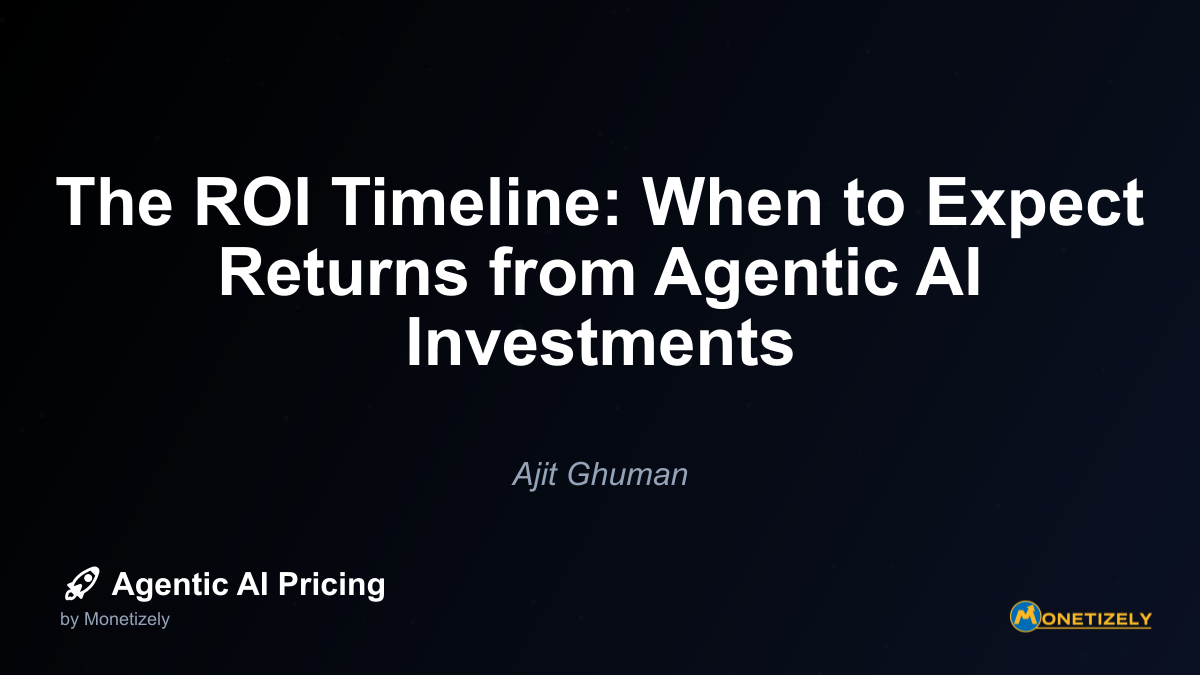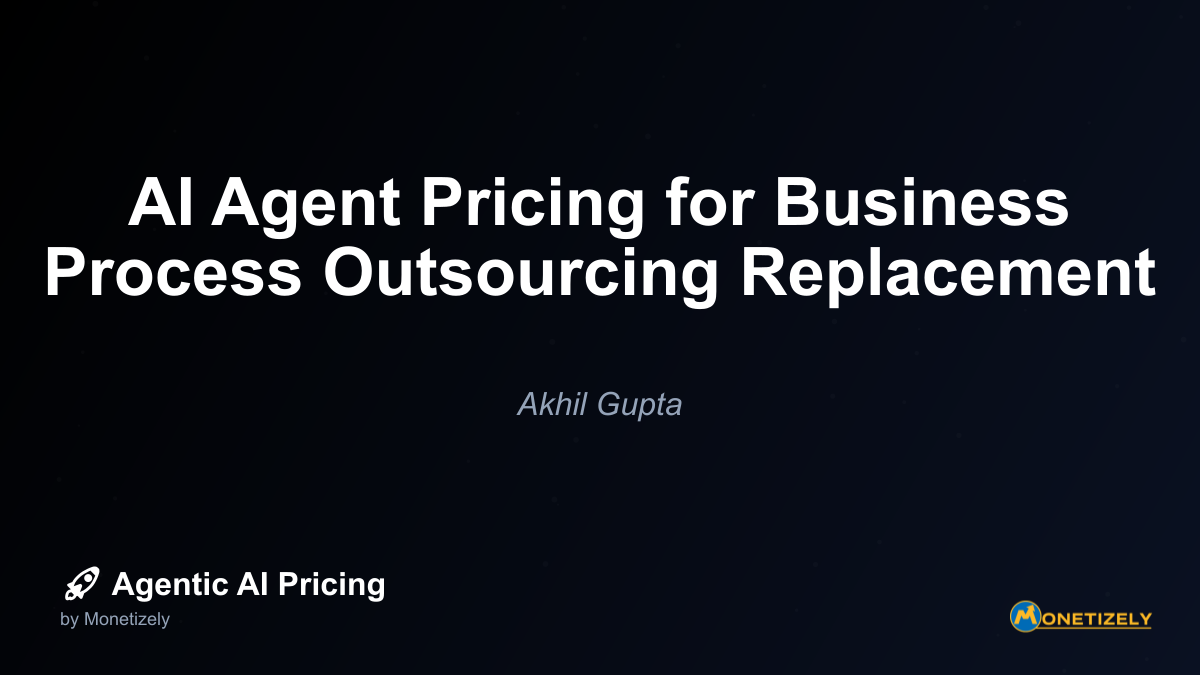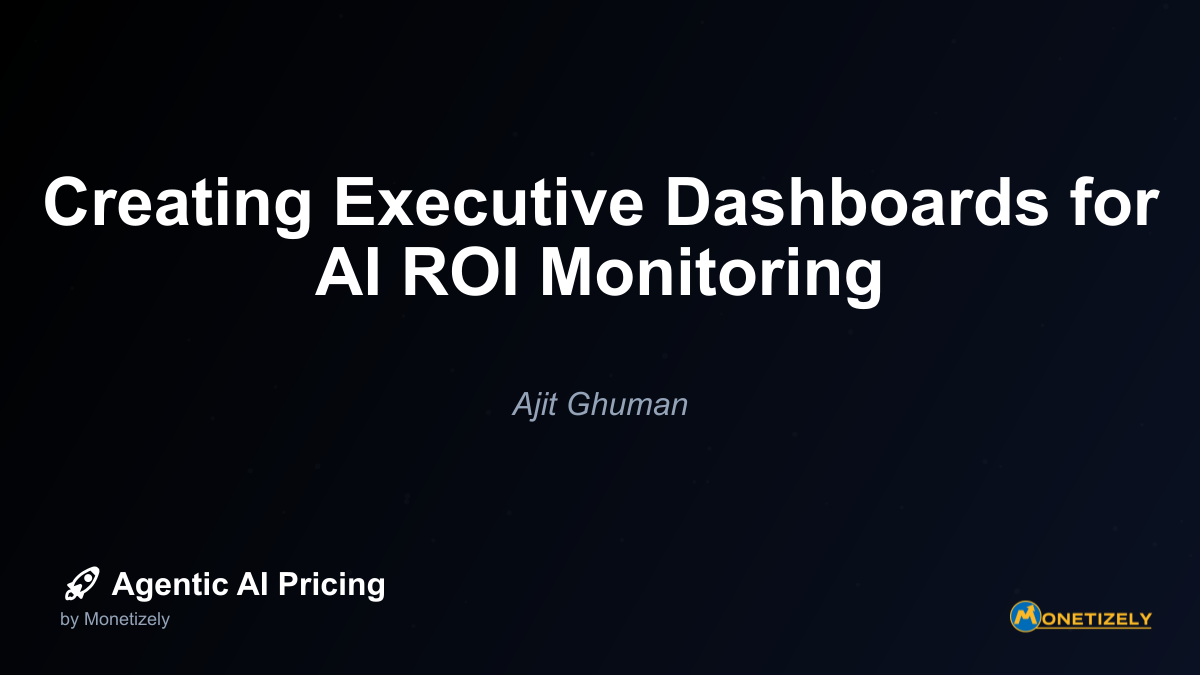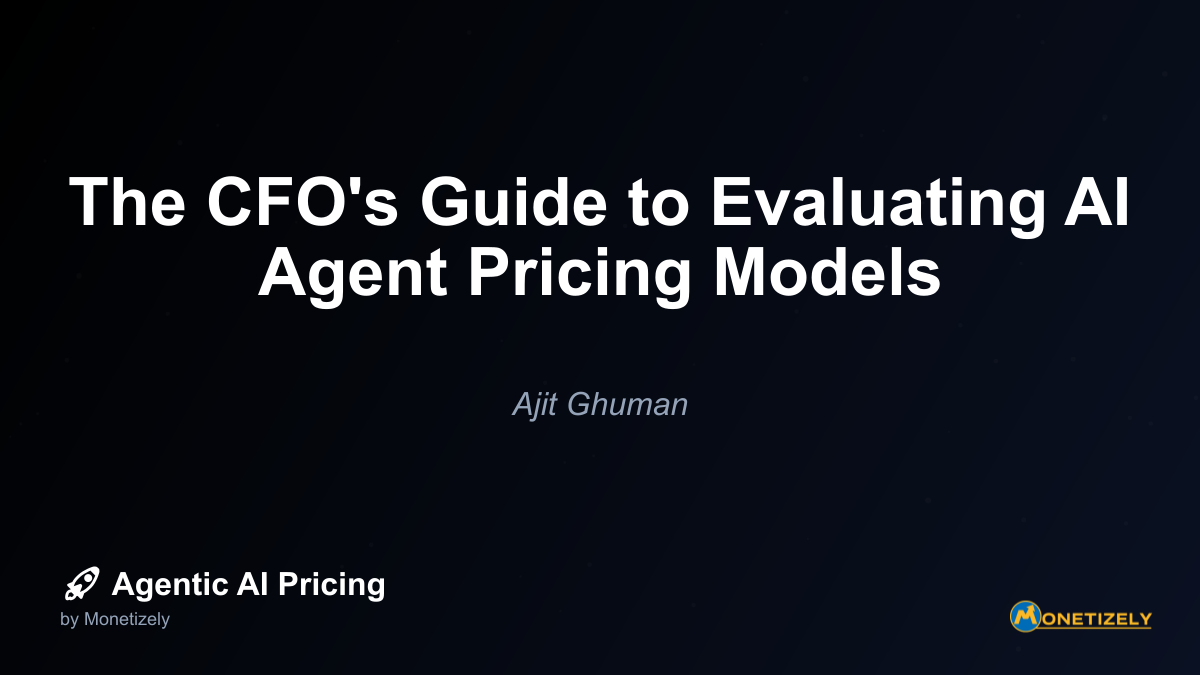· Ajit Ghuman · ROI and Value · 10 min read
Sharing Risk and Reward: Outcome-Based Pricing and ROI Alignment.
AI and SaaS Pricing Masterclass
Learn the art of strategic pricing directly from industry experts. Our comprehensive course provides frameworks and methodologies for optimizing your pricing strategy in the evolving AI landscape. Earn a professional certification that can be imported directly to your LinkedIn profile.
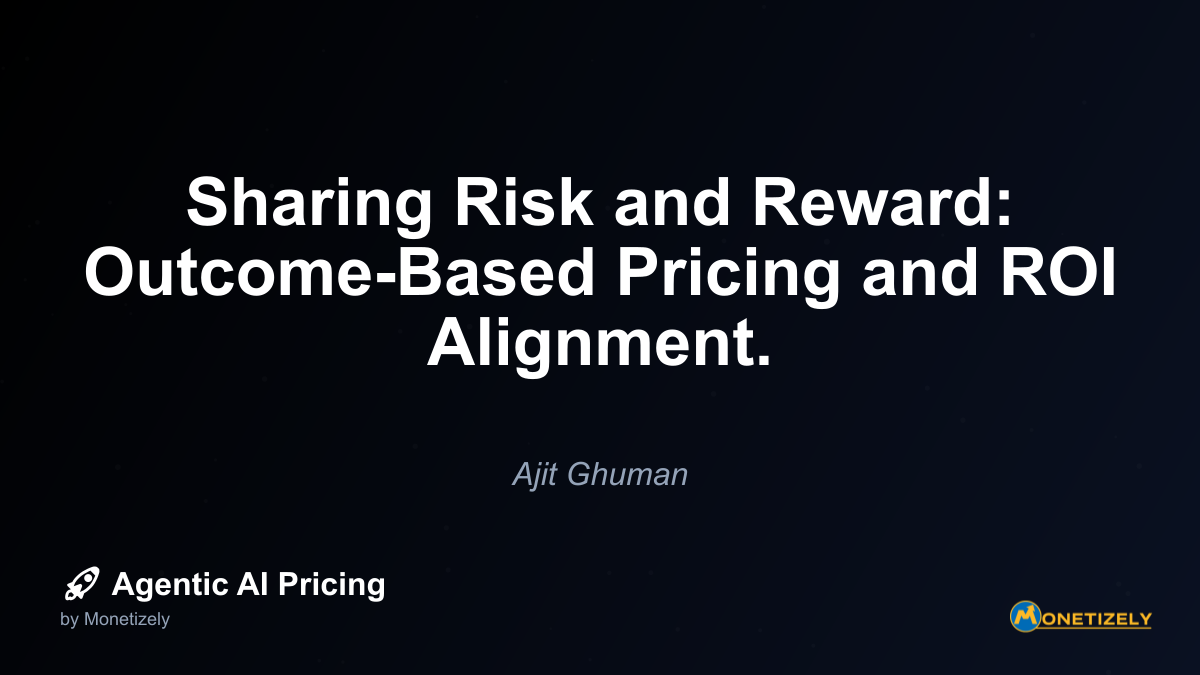
The traditional software pricing model has long followed a predictable pattern: pay for licenses or subscriptions regardless of results. But as agentic AI transforms business capabilities, it’s simultaneously revolutionizing how technology is monetized. Outcome-based pricing models—where vendors only get paid when they deliver measurable results—are emerging as a powerful approach for aligning incentives between AI providers and their customers.
This fundamental shift creates a natural risk-sharing mechanism that builds trust and accelerates adoption of advanced AI solutions. When a vendor’s compensation depends directly on delivering tangible outcomes, customers gain confidence that their investment will generate real returns.
What Is Outcome-Based Pricing in the Agentic AI Context?
Outcome-based pricing (sometimes called performance-based or results-based pricing) ties payment directly to the achievement of predefined business objectives. Unlike traditional models where customers pay regardless of results, outcome-based approaches ensure vendors only receive compensation when they deliver measurable value.
In the agentic AI landscape, this model is particularly compelling. Agentic AI systems—autonomous software agents that perform tasks on behalf of users—can deliver quantifiable outcomes in ways previous technologies couldn’t. These systems can generate leads, close sales, optimize operations, reduce costs, or increase revenue with minimal human intervention.
The pricing structure typically includes:
- Base fee: A minimal fixed payment covering basic costs
- Performance component: Variable payments linked to specific outcomes
- Success metrics: Clearly defined KPIs determining payment triggers
- Measurement mechanisms: Systems for tracking and verifying results
For example, an agentic AI sales assistant might be priced with a modest monthly subscription plus a percentage of revenue from deals it helps close. An AI customer service agent might charge based on resolution rates or customer satisfaction scores. A manufacturing optimization AI could be compensated based on documented cost reductions.
Why Outcome-Based Pricing Creates Natural Alignment
The beauty of outcome-based pricing lies in its inherent alignment of interests. When a vendor only gets paid for delivering results, their success becomes directly tied to their customer’s success.
This alignment manifests in several ways:
1. Shared Investment in Success
With outcome-based pricing, both parties have skin in the game. The vendor invests resources upfront, often with limited guaranteed compensation. The customer provides access to their systems and data. This mutual investment creates a partnership mentality rather than a transactional relationship.
The vendor becomes deeply invested in the customer’s success, as their own revenue depends on it. This naturally leads to greater collaboration, more attentive service, and a focus on long-term outcomes rather than short-term gains.
2. Elimination of Adoption Risk
One of the biggest barriers to AI adoption is risk—the fear that expensive systems won’t deliver promised returns. Outcome-based pricing effectively transfers much of this risk from the customer to the vendor.
If the AI solution fails to perform, the customer’s financial exposure is limited. This risk transfer makes decision-makers more willing to approve AI implementations that might otherwise be deemed too speculative.
3. Focus on Measurable Value
Traditional pricing models can encourage vendors to emphasize features over outcomes. Outcome-based approaches reverse this dynamic, focusing everyone’s attention on the metrics that actually matter to the business.
This results-oriented mindset ensures that development priorities align with customer objectives. Features are only valuable insofar as they contribute to the agreed-upon outcomes.
4. Ongoing Optimization Incentives
When payment depends on performance, vendors have powerful incentives to continuously improve their solutions. Rather than selling a product and moving on, they remain engaged in ensuring the AI delivers increasingly better results over time.
This creates a virtuous cycle where the vendor constantly enhances the solution, the customer receives growing value, and the relationship strengthens through shared success.
When Does Outcome-Based Pricing Work Best?
While outcome-based pricing offers compelling benefits, it’s not universally applicable. This model thrives under specific conditions:
Clear, Measurable Outcomes
The success of outcome-based pricing hinges on the ability to define and measure results objectively. Ideal applications have:
- Quantifiable metrics (revenue, cost savings, conversion rates)
- Clear attribution mechanisms
- Reasonable measurement timeframes
- Limited external variables affecting outcomes
For instance, an AI sales agent can be evaluated on leads generated or deals closed—metrics that are straightforward to track and attribute. Conversely, an AI system aimed at “improving corporate culture” would be challenging to price on outcomes due to measurement difficulties.
Significant Potential Value
Outcome-based pricing works best when the potential value creation is substantial. The model requires vendors to assume risk and potentially delay revenue, which is only economically viable when the upside is significant.
High-value applications like revenue generation, major cost reduction, or substantial efficiency improvements are ideal candidates. Lower-value use cases may not justify the complexity of outcome-based arrangements.
Controllable Variables
For vendors to accept outcome-based terms, they need reasonable control over the factors affecting success. When outcomes depend heavily on customer actions or external factors, pure outcome-based models become problematic.
The ideal scenario gives the AI solution sufficient autonomy to drive results without excessive dependence on customer resources or market conditions outside anyone’s control.
Data Accessibility
Outcome-based models require access to relevant data for both performance optimization and results verification. Without transparent, accessible data, these arrangements quickly break down into disputes over measurement and attribution.
Before implementing outcome-based pricing, both parties must agree on data access protocols, measurement methodologies, and verification processes.
Practical Implementation Approaches
Implementing outcome-based pricing requires thoughtful design to balance risk, reward, and practical considerations. Several approaches have proven effective:
Tiered Outcome Models
Rather than an all-or-nothing approach, tiered models create multiple success levels with corresponding compensation. This approach acknowledges that outcomes exist on a spectrum rather than binary success/failure.
A tiered model might look like:
- Tier 1 (Baseline): Minimum performance level triggering basic payment
- Tier 2 (Target): Expected performance level with standard compensation
- Tier 3 (Exceptional): Outstanding results earning premium payments
This structure provides vendors some protection against complete failure while still maintaining the performance incentive.
Hybrid Pricing Structures
Pure outcome-based pricing places significant risk on vendors. Hybrid models distribute this risk more evenly by combining:
- Fixed components covering base costs
- Outcome-based components tied to results
- Volume-based elements reflecting usage
For example, an agentic AI might charge a modest platform fee, usage-based compute costs, and a performance fee tied to business outcomes. This balances predictable revenue for the vendor with performance incentives.
Phased Implementation
Many successful outcome-based arrangements begin with a more traditional model before transitioning to performance-based terms. This phased approach allows:
- Baseline establishment during initial deployment
- Relationship building and trust development
- Refinement of measurement methodologies
- Gradual risk transfer as confidence grows
A common pattern starts with a conventional subscription model for the first 3-6 months, then transitions to an outcome-based approach once the solution has demonstrated its capabilities.
Capped Risk and Reward
To make outcome-based pricing more palatable to both parties, many agreements include caps on both downside risk and upside potential:
- Minimum payments ensuring vendors cover basic costs
- Maximum payment thresholds preventing runaway compensation
- Renegotiation triggers when outcomes fall outside expected ranges
These guardrails provide certainty while preserving the fundamental alignment between vendor success and customer outcomes.
Overcoming Common Challenges
Despite its advantages, outcome-based pricing faces several implementation challenges:
Attribution Complexity
In complex business environments, attributing outcomes specifically to the AI solution can be difficult. Was the revenue increase due to the AI, the marketing campaign, or market conditions?
Addressing this challenge requires:
- Sophisticated attribution models
- Control group methodologies when possible
- Clear documentation of AI actions and impacts
- Regular review of attribution mechanisms
The most successful implementations use multiple measurement approaches to triangulate impact and reduce attribution disputes.
Extended Sales Cycles
Outcome-based deals typically take longer to close than traditional arrangements. The additional complexity requires more stakeholder involvement and more detailed negotiation of terms.
Vendors can streamline this process by:
- Developing standardized outcome frameworks
- Creating clear ROI calculators
- Providing case studies of similar implementations
- Offering simplified starter packages with predefined metrics
These approaches reduce the custom work required for each new customer while maintaining the outcome-based alignment.
Cash Flow Management
For vendors, outcome-based pricing can create cash flow challenges. The delay between implementation and payment based on results requires careful financial planning.
Successful vendors address this through:
- Portfolio approaches balancing different customer payment timelines
- Upfront payments covering implementation costs
- Milestone-based payment triggers throughout the customer journey
- External financing leveraging contracted future payments
These strategies help vendors manage the financial implications of outcome-based models while maintaining their focus on customer results.
Setting Appropriate Targets
Finding the right balance in outcome targets is critical. Set them too high, and the vendor rarely gets paid despite creating value. Set them too low, and the customer overpays for modest results.
Effective target-setting involves:
- Industry benchmarking to establish realistic expectations
- Pilot periods to gather baseline performance data
- Regular reassessment of targets as conditions change
- Shared governance committees to address target adjustments
The most successful implementations treat targets as living elements that evolve with the relationship and changing business conditions.
Real-World Applications Driving Success
Outcome-based pricing is already transforming how agentic AI systems are deployed across industries:
Sales Acceleration
AI sales agents are increasingly compensated based on their contribution to revenue. These systems identify prospects, nurture relationships, and even close deals with minimal human intervention.
The outcome-based model typically includes:
- Payment per qualified lead generated
- Commission on closed deals
- Bonuses for exceeding target conversion rates
- Adjustments based on customer lifetime value
This approach allows companies to scale their sales operations without fixed cost increases, paying only for actual business growth.
Customer Service Optimization
Agentic AI customer service solutions are revolutionizing support operations, with pricing tied directly to resolution metrics and satisfaction scores.
Typical structures include:
- Payments per successfully resolved ticket
- Bonuses for first-contact resolution
- Adjustments based on customer satisfaction ratings
- Penalties for escalations requiring human intervention
This model incentivizes the development of increasingly capable AI agents that can handle complex issues independently.
Marketing Performance
AI-driven marketing systems are adopting outcome-based pricing tied to campaign performance and customer acquisition costs.
Common approaches include:
- Payment per qualified lead
- Fees based on conversion rate improvements
- Compensation tied to customer acquisition cost reduction
- Revenue sharing for customer reactivation
These models ensure marketing budgets directly correlate with actual business results rather than activity metrics.
Supply Chain Optimization
Agentic AI systems optimizing supply chains are increasingly compensated based on cost reduction and efficiency improvements.
Typical structures include:
- Percentage of documented cost savings
- Fees tied to inventory reduction while maintaining service levels
- Payments based on throughput improvements
- Compensation linked to forecast accuracy enhancement
These arrangements ensure the AI provider is rewarded specifically for tangible operational improvements.
Building Trust Through Shared Risk
Perhaps the most powerful aspect of outcome-based pricing is its ability to build trust in emerging AI capabilities. By willingly accepting payment only for results, vendors demonstrate profound confidence in their solutions.
This trust-building effect is particularly valuable for agentic AI, which represents a significant leap beyond traditional automation. When customers see vendors willing to stake their compensation on performance, adoption barriers fall dramatically.
The trust developed through shared risk creates a foundation for expanded implementation. Initial successes in one department often lead to broader adoption across the organization, with the proven ROI from outcome-based arrangements providing compelling evidence for further investment.
The Future of AI Monetization
As agentic AI continues to mature, outcome-based pricing will likely become the dominant monetization model for high-value applications. This evolution will drive several trends:
Increased Measurement Sophistication
The industry will develop increasingly sophisticated measurement frameworks to address attribution challenges. AI-specific ROI methodologies will emerge, combining multiple approaches to isolate and quantify the impact of autonomous systems.
Standardization of Outcome Metrics
Industry standards will develop around common outcome metrics for specific AI applications. These standardized frameworks will simplify contracting and enable better benchmarking across implementations.
Financial Ecosystem Development
New financial services will emerge to support outcome-based AI businesses. These might include specialized financing for vendors awaiting outcome payments, insurance products covering performance risk, and investment vehicles based on contracted future AI outcomes.
Marketplace Evolution
AI marketplaces will increasingly feature outcome-based offerings, with standardized metrics and pricing structures. This will accelerate adoption by reducing the custom negotiation currently required for each implementation.
Conclusion
Outcome-based pricing represents a fundamental shift in how technology creates and captures value. By aligning vendor compensation directly with customer results, these models create natural partnerships focused on measurable business impact.
For agentic AI—with its unprecedented ability to autonomously drive business outcomes—this pricing approach is particularly powerful. It addresses adoption concerns, focuses development on what truly matters, and creates sustainable relationships built on delivered value rather than promised capabilities.
As the AI landscape continues to evolve, organizations that master outcome-based models will enjoy significant advantages. Customers benefit from reduced risk and better results, while vendors build more valuable, sustainable businesses based on proven performance.
The future belongs to those who can effectively share both risk and reward—creating technology partnerships where success is truly mutual.
Co-Founder & CEO
Ajit is the author of Price To Scale, a top book on SaaS Pricing and is the Founder of Monetizely. Ajit has led and worked in pricing and product marketing at firms like Twilio, Narvar and Medallia. His work has been featured in Forbes and VentureBeat. Ajit regularly consults with software companies from Seed stage to post-IPO on pricing strategy. Ajit is also a highly-rated co-instructor for 'The Art of SaaS Pricing and Monetization' on Maven.
Pricing Strategy Audit
Let our experts analyze your current pricing strategy and identify opportunities for improvement. Our data-driven assessment will help you unlock untapped revenue potential and optimize your AI pricing approach.

